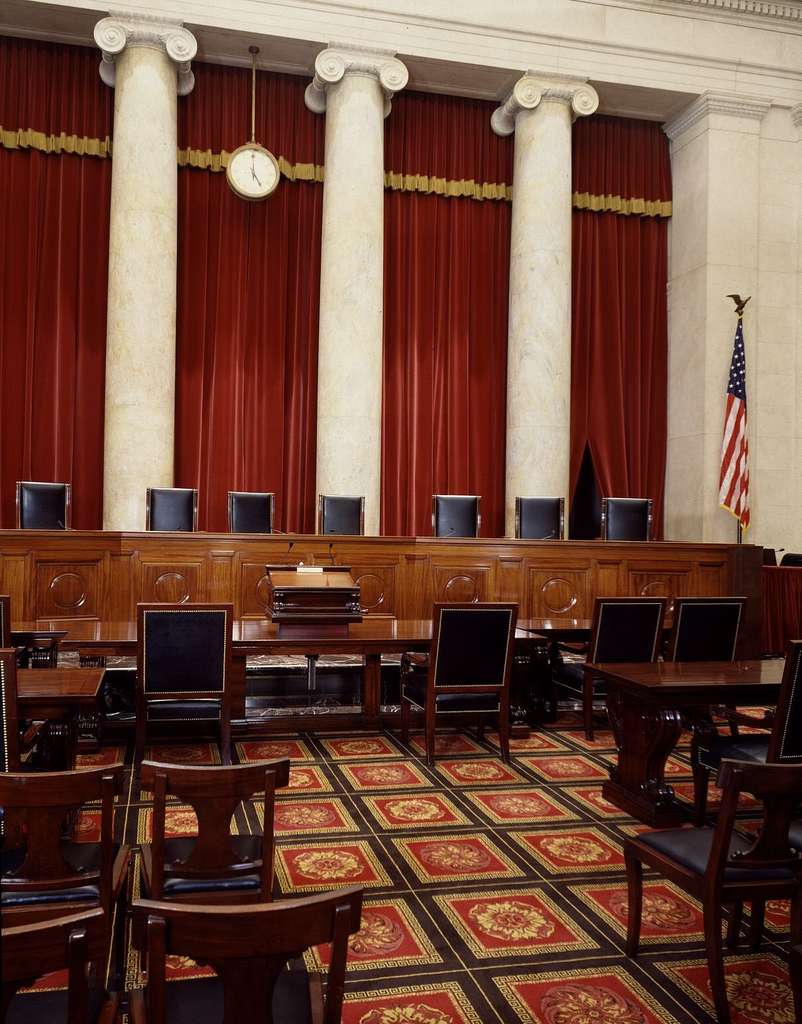
Kavanaugh May Be Open to Restoring Strict Scrutiny Review in Free Exercise Cases
Raphael A. Friedman
Chambers of the US Supreme Court by Carol M. Highsmith.
On March 24, for the third time in two years, the Supreme Court sided with a religious inmate on death row who wished to have his spiritual advisor in the room at the time he would be put to death. In the prior cases, the Court held that Texas and Alabama, respectively, could not keep clergy members out of execution rooms. But in this case, John Ramirez also wanted his religious advisor of six years, Pastor Dana Moore, to lay his hands on Ramirez and audibly pray while the State of Texas executed him. Ramirez explained in a grievance to the Texas prison system that “part of my faith [is] to have my spiritual advisor lay hands on me anytime I am sick or dying.”
In an 8-1 decision, the Court held that federal law required Texas to allow Pastor Moore to touch Ramirez and audibly pray during his execution (which was most recently scheduled for September 8, 2021.)
Under the Religious Use and Institutionalized Person Act of 2000 (RLUIPA), a state may not substantially burden an inmate’s religious exercise unless it can demonstrate two things: one, that a compelling state interest warrants the interference with religious practice, and two, that the state has employed the means least restrictive to religious practice in order to achieve its interest. The Court held that Texas failed to meet both of these standards, while expressly withholding judgment on whether the Constitution’s Free Exercise Clause would require the same result.
Justice Kavanaugh joined the majority’s opinion in full but wrote a concurring opinion to “add three points.” The second one caught my attention.
I recently argued that the Supreme Court should overrule its 1990 landmark decision Employment Division v. Smith, a case that significantly limited the extent to which government must accommodate religion. Per Smith, whenever a law is both neutral toward religion and generally applicable, the law withstands challenge — no matter the burden on religious practice. In essence, according to Smith, the Constitution does no more to protect religious exercise than proscribe blatant discrimination against religion.
RLUIPA, and a sister federal law, the Religious Freedom and Restoration Act of 1993 (RFRA), were enacted in direct response to Smith. Their express purpose was to afford greater legal protection to religious practice.
The swift congressional response to Smith was unsurprising, considering the decision upended decades of free exercise jurisprudence. Pre-Smith, a law that burdened a sincerely held religious belief needed to satisfy both prongs of what ultimately became the RLUIPA (and RFRA) standard: the law must further a compelling state interest and be narrowly tailored to accommodate religion.
As the Court explained in Wisconsin v. Yoder (a leading pre-Smith free exercise case that held Wisconsin could not compel children of an Old Order Amish religious community to attend school beyond the eighth grade): “[a] regulation neutral on its face may in its application, nonetheless offend the constitutional requirement for governmental neutrality if it unduly burdens the free exercise of religions.”
In its poorly reasoned Smith decision, the Court swept away precedent to make way for what purported to be more objective criteria: the law’s neutrality toward religion and its general applicability.
Recently, the Court had the opportunity to overrule Smith in Fulton v. Philadelphia, a case involving a Philadelphia Catholic social services agency that does not, on religious grounds, work with married same-sex couples seeking to adopt children.
The Court unanimously ruled in favor of the religious agency, but Smith survived. Three justices concurred in the judgment of the Court but would have gone further and overruled Smith. Justice Amy Coney Barrett wrote a separate concurring opinion, agreeing with the majority in full, while adding her displeasure with the Smith decision but expressing concerns about what should replace it.
Most proponents for overturning Smith argue the decision flouted the precedent that held the Free Exercise Clause requires strict review of any law that burdens religious exercise, even those that are neutral and generally applicable.
Justice Barrett noted, “[t]he prevailing assumption seems to be that [if Smith were overruled] strict scrutiny would apply whenever a neutral and generally applicable law burdens religious exercise.” Strict scrutiny is the legal term for the compelling interest and narrowly tailored standard found in RLUIPA and RFRA. To put it another way, most proponents for overturning Smith argue the decision flouted the precedent that held the Free Exercise Clause requires strict review of any law that burdens religious exercise, even those that are neutral and generally applicable. Therefore, if Smith was dealt the death-knell, it should follow that the strict scrutiny standard for adjudicating free exercise cases would return.
But Justice Barrett was less than enthusiastic about that result, writing that she “is skeptical about swapping Smith’s categorical antidiscrimination approach for an equally categorical strict scrutiny regime.” She argued that a more “nuanced” approach to free exercise cases would better align with the Court’s jurisprudence on other First Amendment rights.
I’m somewhat puzzled as to how Justice Barret can call strict scrutiny “an equally categorical…regime” when the very essence of strict scrutiny review requires courts to weigh, on a case by case basis, the relative interests of the government and the affected religious individuals.
In any event, Kavanaugh joined in Justice Barrett’s opinion, apparently sharing her doubts about replacing Smith with a strict scrutiny regime.
Yet, in his concurrence in Ramirez, Kavanaugh appeared to back away from the Barrett concurrence, at least to some extent. He first noted the “difficulty” courts face when deciding “whether a State’s asserted interest is sufficiently ‘compelling’” and “whether less restrictive means could satisfy that compelling interest.” He warned against courts using their “own intuitive policy assessment” in answering these questions. (It’s worth noting that this concern is almost certainly what animated the Smith decision, authored by the late Justice Antonin Scalia, in the first place. Scalia disdained legal “balancing tests,” because he felt they invite judicial policymaking.)
But Kavanaugh went on to applaud the Court’s use of two data-points to buttress their answers to these tough questions: “history and state practice.”
In concluding that Texas must allow Pastor Moore to pray and lay hands on Mr. Ramirez during his execution, Chief Justice John Roberts, writing for the majority, pointed to the “long history” of such prayer, which predates our Nation’s founding. According to Roberts, the historical record casts doubt on Texas’s assertion that an outright ban on the practice is the least restrictive means of achieving its stated interest.
Additionally, in rejecting Texas’s feeble justification that audible prayer may “prove distracting during an emergency,” Roberts noted that Texas failed to differentiate itself from other jurisdictions that allow it, including the Federal Government, the state of Alabama and, in the past, even Texas itself.
Kavanaugh’s concurrence, to be sure, did not suggest that history and state practice are a silver bullet, and for that reason he may still favor an alternative to strict scrutiny should Smith be overruled.
Moreover, the posture of the Barret concurrence in Fulton and the Kavanaugh concurrence in Ramirez are analytically distinct. Ramirez was a RLUIPA case, making strict scrutiny review inevitable because Congress has written that standard into law. Therefore, the Supreme Court is bound to abide by it. Fulton on the other hand was a free exercise case and, as with all matters of Constitutional law, it is the Court who decides what the standards of review should be. Kavanaugh may continue to believe that strict scrutiny is not ideal but recommend using history and state practice in RLUIPA cases, for which strict scrutiny is inevitable.
All that notwithstanding, Kavanaugh seems somewhat open to the notion of strict scrutiny review for religion cases if courts use what he views as more objective reference points to decide them. He wrote: “[H]istory and state practice can at least help structure the [the strict scrutiny] inquiry and focus the Court’s assessment of the State’s arguments.”
Kavanaugh seems somewhat open to the notion of strict scrutiny review for religion cases if courts use what he views as more objective reference points to decide them.
Consulting history and state practice to decide free exercise cases is not a novel idea. In Yoder, decided in 1971, for example, the Court relied heavily on history and state practice when analyzing whether the state had a compelling interest in refusing to exempt Amish 14 and 15-year-old-children from compulsory education laws. The Court noted that the “requirement for compulsory education beyond the eighth grade is a relatively recent development in our history,” and that other states beside Wisconsin had more flexible educational requirements.
Similarly, the Court looked to other states’ practices in a footnote to their decision in Sherbert v. Verner, a 1963 decision that held the Free Exercise Clause required South Carolina to allow Sabbath observers to receive unemployment benefits even if they declined work opportunities that would require them to work on their day of rest. (“We note that, before the instant decision, state supreme courts had, without exception, granted benefits to persons who were physically available for work but unable to find suitable employment solely because of a religious prohibition against Saturday work.”)
Kavanaugh’s view on whether strict scrutiny review is a feasible replacement for the Smith standard is not trivial. In the last few years, the Court has entertained far more cases about religious freedom than in decades past. A proliferation of religion cases in federal district courts relating to COVID-19 restrictions on houses of worship and mandatory vaccination laws are part of the reason. But more generally, this Supreme Court seems uniquely interested in ruling on free exercise cases. It seems likely that it will only be a matter of time before another case like Fulton, that calls Smith’s vitality into question, will be on the docket. Taking a predictive tally, we already know from their dissenting opinions in Fulton that Justices Thomas, Alito, and Gorsuch are ready to overturn Smith in favor of returning to a strict scrutiny regime for free exercise cases. The Court’s liberal minority, composed of Justices Breyer (set to retire at the end of the term and be replaced by his former law clerk, Judge Ketanji Brown Jackson), Sotomayor, and Kagan, is highly unlikely to favor overruling Smith. That leaves Roberts, Kavanaugh, and Barrett. In Fulton, Kavanaugh and Barrett strongly implied they would overrule Smith, if the right case came to their desks. With at least a 5-4 majority ready to put Smith to bed, what each of the Justices think should replace it, will likely affect the future of Free Exercise jurisprudence. ♦

Raphael A. Friedman is an associate at a New York City litigation boutique and a graduate of New York University School of Law who has written on the Free Exercise Clause, juvenile sentencing, the intersection of tort and administrative law, and parental rights.
Recommended Citation
Friedman, Raphael A. “Kavanaugh May Be Open to Restoring Strict Scrutiny Review in Free Exercise Cases.” Canopy Forum, June 28, 2022. https://canopyforum.org/2022/06/28/kavanaugh-may-be-open-to-restoring-strict-scrutiny-review-in-free-exercise-cases/

